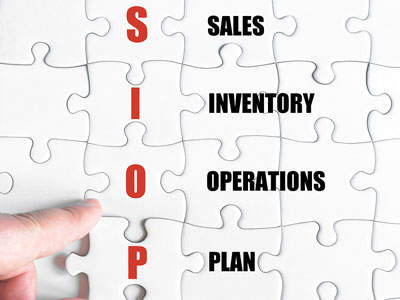According to an informal survey of manufacturers, distributors and healthcare executives, the #1 issue that is top of mind is how to scale successfully. Our clients are growing. For example, those in the building and construction products industry are experiencing significant growth fueled by the pandemic; those in e-commerce are growing faster than imaginable as Amazon-like shopping is the norm; outdoor activity products have been flying off the shelves and don’t seem to be slowing down; and logistics is currently so busy that there are increasing prices, backlogs of ships and more. Of course, if you are in commercial aerospace or hospitality products, your volume has dropped; however, as these industries recover, scalability will become a hot button topic. SIOP (Sales Inventory Operations Planning) will be a key to scaling successfully.
How does SIOP help scalability?
First, we must start with customers. What will your customers need in the future? By NO means should we assume the past will dictate the future. Pre-pandemic sales are no longer relevant. Sales that occurred during lockdowns are irrelevant. Not only has product mix changed but buying behaviors have evolved and service expectations have changed. So, what is relevant? Find out what your customers’ customers need. Bring market intelligence to the forefront. Align demand inputs, put together a directionally-correct forecast and continuously evolve with the SIOP process.
Next, focus on manufacturing and supply chain. What are you producing inhouse vs. purchasing? Given changes in the demand plan, do you have enough manufacturing capacity? Should you purchase machinery and equipment? Should you run overtime, hire people, bring on more temporary employees or improve performance to meet demand spikes? Or, should you partner with other manufacturers temporarily, form alliances or outsource? As your customers’ expectations change, how does it affect your service requirements and therefore your manufacturing capacity, production schedules and materials/ ingredients purchases? Should you locate manufacturing capabilities closer to customers? Can you dedicate a percentage of capacity for last-minute customer requirements?
If you have multiple sites and a distribution network, how do the changing customer requirements and revenue forecast impact distribution plans? Of course, warehouse capacity needs to be reviewed. Transportation strategies should be adjusted. Planning systems (forecasting, advanced planning and scheduling, MPS, MRP, DRP etc.) should be tweaked to evolving conditions.
In terms of purchasing and supply, there are many considerations. Will the 13 week lead times from Asia to N.A. be acceptable? Do you have diversity within your supply base? For example, if your backup supplier to a material you purchase from Wuhan, China is located in another area of China, you don’t have a backup source of supply! Clients with a backup supplier in India (with the main supplier in China) also experienced significant disruption during the pandemic. What if both suppliers use the same ports or travel through the Suez Canal? You are likely to have an issue. Reevaluate the risks and potential disruptions in your supply chain vs. your customer requirements and need for responsiveness. Develop supplier forecasts. Understand supplier capacity and overflow options.
Last but not least, the reason 100% of clients choose the title of SIOP instead of S&OP is because inventory is relevant. During the pandemic, those clients with cash reserves were far more successful than those with minimal cash reserves. In fact, cash constrained companies went out of business or had to sell at bottom basement prices. Projecting inventory needs is certainly relevant to financial success. Increasing inventory levels can cover unanticipated demand and supply chain disruptions. On the other hand, increasing inventory can create storage issues, warehouse inefficiencies, and other unintended consequences. There are no easy answers except to align demand with supply.
SIOP aligns demand and supply to enable growth with increased customer service, profitability and accelerated cash flow. Refer to our blog for many articles on SIOP. Also, read more about these types of strategies in our eBook, SIOP (Sales Inventory Operations Planning): Creating Predictable Revenue and EBITDA Growth. If you are interested in talking about what it would take to purse the SIOP journey in your business, contact us.
Did you like this article? Continue reading on this topic:
SIOP/ S&OP and Bottom Line Benefits



